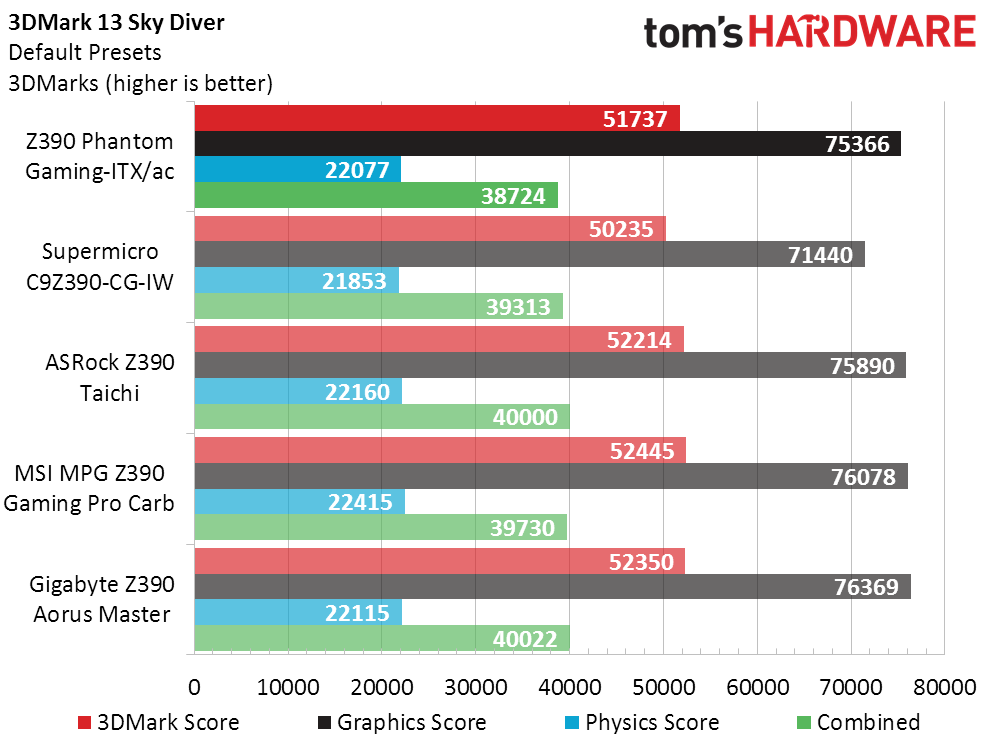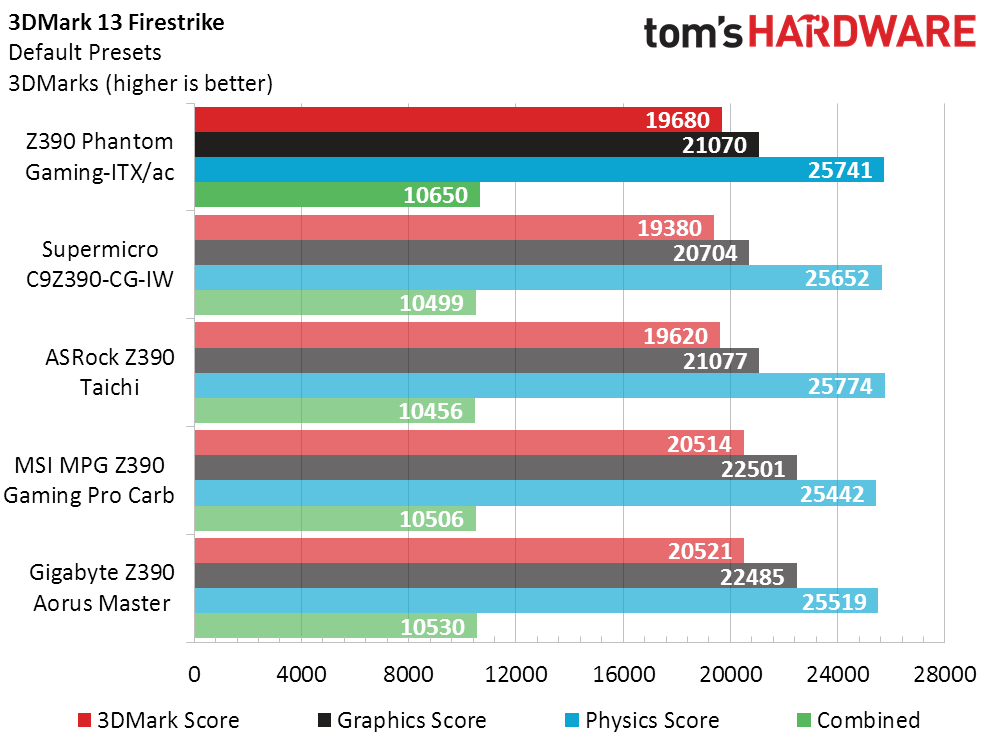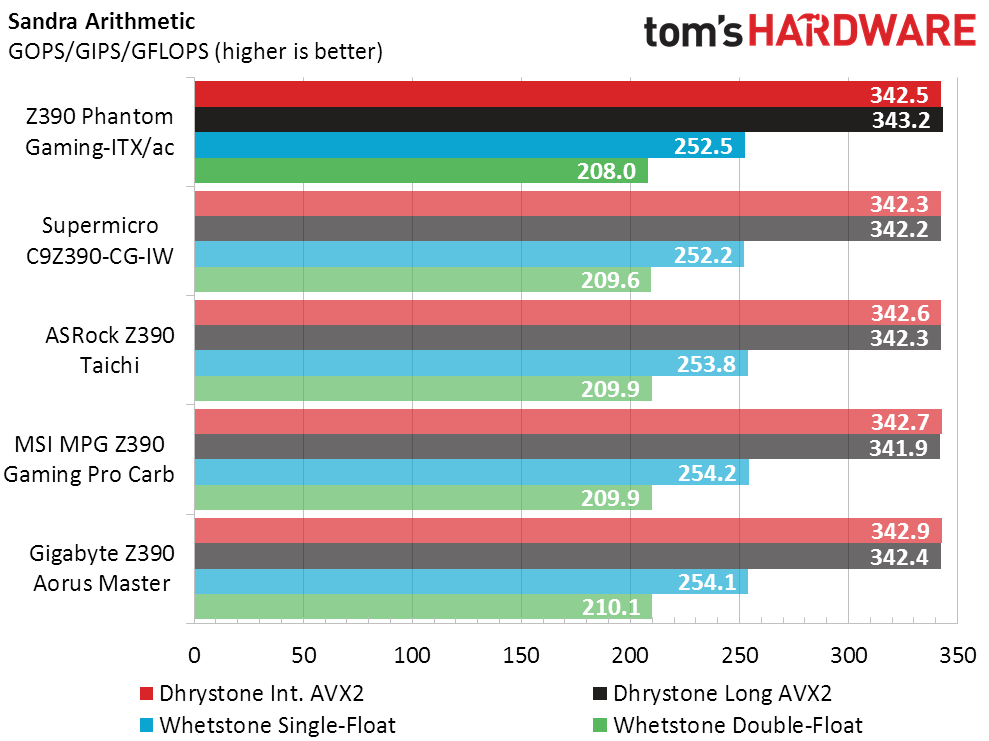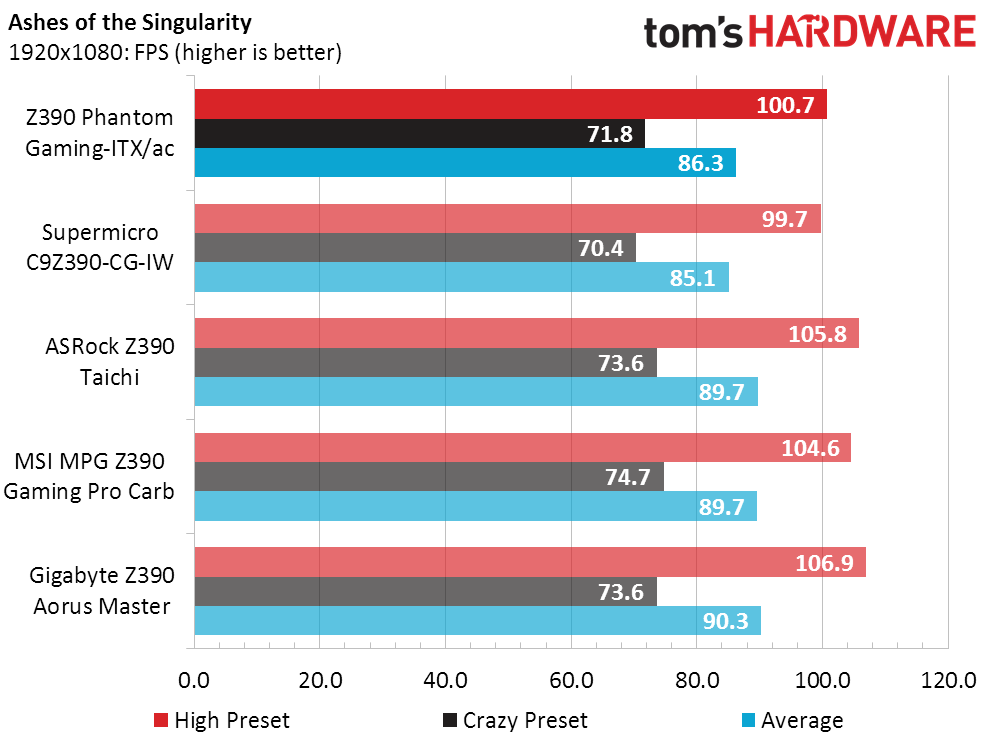ASRock Z390 Phantom Gaming-ITX/ac Review: ITX Excellence
Why you can trust Tom's Hardware
Benchmark Results and Final Analysis
Most enthusiast-class motherboards employ a type of overclocking that ignores the CPU’s lower all-core Turbo Boost mode and instead deploys its highest single (or two) core Turbo Boost ratio regardless of the load. While most boards currently don’t do that with the Core i9-9900K, we still make sure the setting is disabled prior to our basic performance and power tests. We also enable all of the CPU’s power-saving features in firmware and leave the memory in its default (non-XMP) mode.
Synthetic Benchmarks
The two Mini ITX board here support only half of our four-DIMM RAM kit, and each module has one rank of 8GB. The Intel memory controller’s preference for at least four ranks of memory had us guessing about the performance impact of using only two ranks on the Z390-CG-IW. But things still look good in 3DMark for the Z390 Phantom Gaming-ITX/ac. It’s not that there’s no performance impact, but the impact is small.










Sandra Cryptography is bandwidth-restricted and impacted by the reduced ranks of the two-DIMM boards, as further illustrated in its Bandwidth benchmark. On the other hand, the performance gap we’d noticed on the competing Supermicro board went away for the Z390 Phatom Gaming-ITX/ac in Compubench.
3D Games




Now that we’ve seen it on a second two-DIMM board, we understand that giving up half of our memory ranks has some impact on all of our games. Though it affects a wider variety of games on the Core i9-9900K than we’d noticed in earlier 8700K tests, the difference appears smaller in the notoriously affected F1 2015.
Timed Applications



Handbrake completion times continue to rise even after we restored our benchmark image. We can only speculate that the SSD may be slowing after repeated reloads. Other than that triviality, the Z390 Phantom Gaming-ITX/ac performs nicely.
Power, Heat, & Efficiency
The Z390 Phantom Gaming-ITX/ac makes enormous strides in energy use, holding the 4.70 GHz eight-core Turbo Boost setting at a mere 1.16V and returning a 60W decrease in power consumption compared to the full-ATX Z390 ASRock Taichi. Conversely, the C9Z390-CG-IW appeared to use Intel’s 5.0 GHz two-core-boost voltage even when running an 8-core load at 4.70 GHz.
Lower voltage levels usually mean cooler temperatures, but we were still a little concerned about the Z390 Phantom Gaming-ITX/ac’s smaller voltage regulator and heat sink here. But it turns out there was no need for our concern.
Get Tom's Hardware's best news and in-depth reviews, straight to your inbox.
Not only was the Z390 Phantom Gaming-ITX/ac the lowest-energy board in the mix, there was only a 0.8% performance deficit attributable to its use of only two modules from our four-DIMM kit. The result is an amazing efficiency score that's 18.7 percent above the average. And while buyers who are only willing to purchase two single-rank DIMMs could save a few watts on one of the larger boards, doing so would cancel out that 0.8-percent performance difference.
Overclocking
Everything we said at the top of the page about enabling power saving features goes out the window in overclocking. We’re seeking the highest 100-percent stable frequency while using Prime95 small-FFT’s to apply a 100% load across all eight cores and sixteen threads.
We mentioned in the firmware section that the Z390 Phantom Gaming-ITX/ac was the first board to run our CPU at 5.0 GHz for a full 40 minutes with all eight cores and 16 threads fully loaded, but that we had to give up on that setting after being unable to get it stable for much more than 40 minutes. We should also mention that the voltage regulator forced thermal throttling after around 20 minutes, and that we had to switch from a roughly 60 CFM to a roughly 160 CFM fan to prevent that from happening. Dropping it back to 4.95 GHz was also necessary to get the voltage regulator temperatures under control. so this really is close to the limit of the stock voltage regulator cooler.
Memory overclocking was the only test we did on all of the big boards in both two and four DIMM configurations, and getting bandwidth numbers from Sandra is part of that process. This version of the bandwidth chart shows how each of these boards looks with two DIMMs at max O/C, and the Z390 Phantom Gaming-ITX/ac appears very competitive. Previous charts showed the 4-DIMM boards getting nearly 40GB/s when all the slots were filled.
Final Analysis
The Z390 Phantom Gaming-ITX/ac only needed to beat the other Mini ITX board Z390 board we've tested so far to declare a victory. It did so in performance, power consumption, heat, efficiency, and overclocking. Though most of the features between these boards are evenly matched, the ASRock board leads by having a Thunderbolt 3 controller--even if the controller only runs at half-bandwidth (20Gb/s). Of course, chipset pathway limitations meant something had to give, and the Z390 Phantom Gaming-ITX/ac lacks the front-panel USB 3.1 Gen2 header of the Supermicro C9Z390-CG-IW. On the other hand, if you have an older case, the ASRock board has the USB 2.0 header that Supermicro left out. Both boards have front-panel USB 3.0 headers.
Even if you never use Thunderbolt 3, it’s hard to deny the supremacy of a board that does everything else better than the competition while costing less. The Z390 Phantom Gaming-ITX/ac is even cheaper than the non-Wi-Fi version of MSI’s MGP Z390 Gaming Pro Carbon, though that won’t matter to anyone who needs the extra DIMM and PCIe slots afforded the ATX form factor. But for those in the market for a Mini ITX board to support Intel’s Core i9-9900K, the Z390 Phantom Gaming-ITX/ac is easily our first choice.
MORE: Best Motherboards
MORE: How To Choose A Motherboard
MORE: All Motherboard Content
-
xidharta I love these reviews of itx boards, I would like to see gigabyte and msi ixt z390, which have a better price, many thanks!Reply -
Crashman Reply
"Everyone" does it, this time it was more egregious than the typical 15-25mV. I'm currently writing up a board that's only 7mV over. Seven. That's incredibly closer to spec than most competing products. Heck, I might just give the new board kudos for ONLY being 7mV over-spec.21470029 said:It'd be nice to see some followup with asrock regarding the dram over voltage...
-
johnphilips I would love to see a roundup between all z390 itx boards, specially the overclocking part.Reply -
eddygonewild Why tom's hardware modifies pictures of reviews with extreme contrast. I can't see under the heatsink fins. Its totally useless, people are coming here to decide, not look at flashy eyecandy.Reply -
Crashman Reply
The images match the profile of my monitor. Maybe I should be using a different monitor?21511630 said:Why tom's hardware modifies pictures of reviews with extreme contrast. I can't see under the heatsink fins. Its totally useless, people are coming here to decide, not look at flashy eyecandy.
-
ioanbordei Thunderbolt port is not working at full speed? 40Gb/s ? Why is running at half (20Gb/s) ?Reply -
Crashman Reply
Because it's using a cheaper PCIe x2 controller.21528908 said:Thunderbolt port is not working at full speed? 40Gb/s ? Why is running at half (20Gb/s) ?






